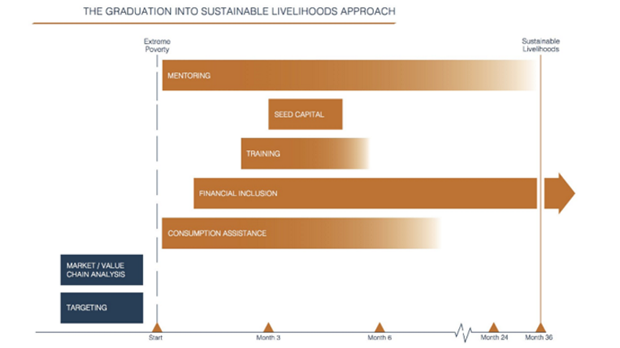How to Make the Graduation Approach Work for Refugees
In recent years, development actors have joined their humanitarian counterparts in tackling the global refugee crisis. Several organizations have been exploring ways to adapt their livelihood programs and other market-based interventions to meet the needs of refugee populations, including the poorest and most vulnerable refugee groups. A growing number have experimented with the graduation approach, which numerous pilots have found to lift families out of extreme poverty.
 The graduation into sustainable livelihoods approach
The graduation into sustainable livelihoods approach
The UN Refugee Agency (UNHCR), the leading humanitarian actor, has integrated this approach into its humanitarian programming in Egypt, Ecuador, Costa Rica and several other fragile countries in Africa. The Costa Rican government now plans to include the graduation approach in its national poverty alleviation efforts with technical support from UNHCR. Successes like these have led UNHCR to feature graduation in its global strategy.
The growing experience that UNHCR and others have with integrating refugees into their livelihood programs raises several questions. How can development actors bring economic stability and social inclusion to refugee and internally displaced populations in precarious socioeconomic and political contexts? What mechanisms need to be in place so that we can enable the poorest within these groups to acquire the skills they need to thrive economically?
CGAP recently tackled these questions in a webinar with three organizations that have significant experience implementing graduation programs for refugees: UNHCR, Trickle Up and HIAS. UNHCR and Trickle Up have been collaborating on graduation programs for refugees in Africa, Middle East and the United States. HIAS is implementing graduation programs for refugees and internally displaced populations in Ecuador and beyond. Some useful lessons emerged from their experience using the approach:
- It’s important to involve host communities. It is critical to include the poorest segments from both refugee and host communities in graduation programs. Involving both populations fosters social cohesion, particularly when working in communities that have reacted to the arrival of refugees with resistance and discrimination. Along with other factors like a proper legal framework, a welcoming host community creates an environment in which refugees can more easily rebuild their lives. There are different ways of bringing refugee and host communities together. As part of its graduation criteria, for example, HIAS required participating families to take part in community activities in an active and sustained way for at least six months.
- Adapt your program to refugees’ mobility. Especially in urban programs, the fact that refugees are highly mobile can create challenges when it comes to participant selection, group training, savings group formation, social network engagement and coaching (case managers must often travel long distances to reach participants, adding to program costs). Basic services are often available in host communities, but refugees and internally displaced people may not be able to access them. According to UNHCR and Trickle Up, it is important to address this situation by coordinating with other programs to advocate for legal reform and educate refugees about their rights to basic services.
- Tailor support to refugees’ legal status. A refugee’s legal status in his or her host country should not be a barrier to participation in graduation programs. However, program leaders do need to consider the legal status of potential participants. People may need different types of support based on their status, as, for example, when it comes to educating participants about what is legally acceptable.
These are important lessons for developing and humanitarian organizations operating at the frontiers of humanitarian crises. Organizations working within the broader graduation space can also draw insights from these experiences. There is a growing need for more extensive research on the costs of graduation programs, the magnitude of their impact on both host and refugee communities, and pathways to scale. Continuing to share lessons learned from the adaptation of the graduation approach in programs targeting refugee and internally displaced populations will be crucial as the global footprint of UNHCR and other organizations grows.




Add new comment